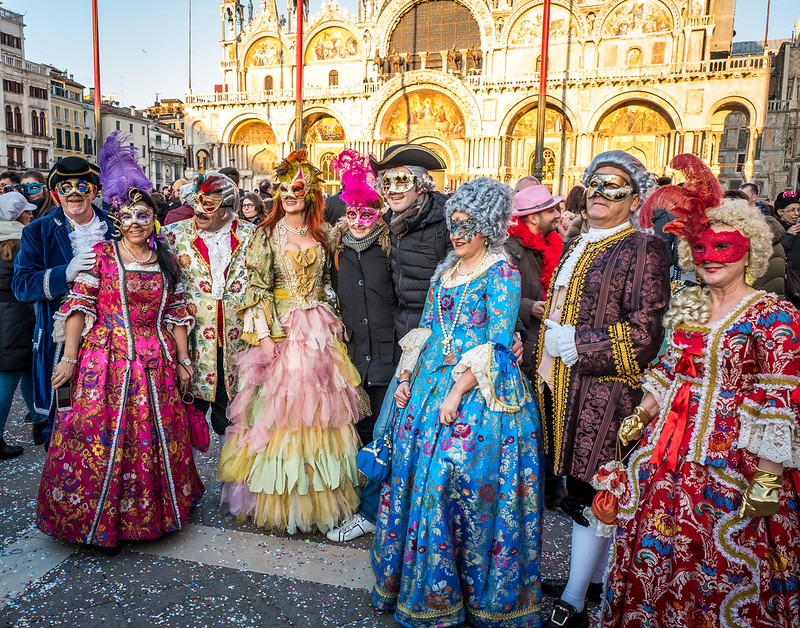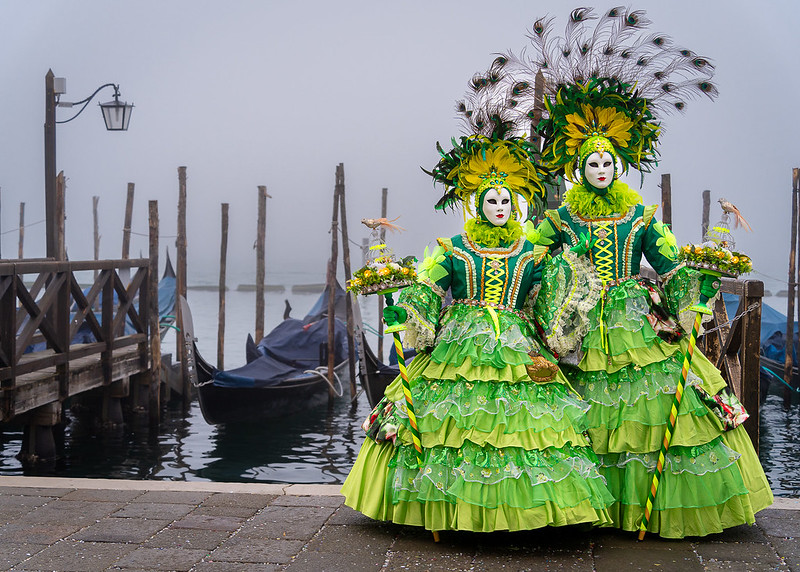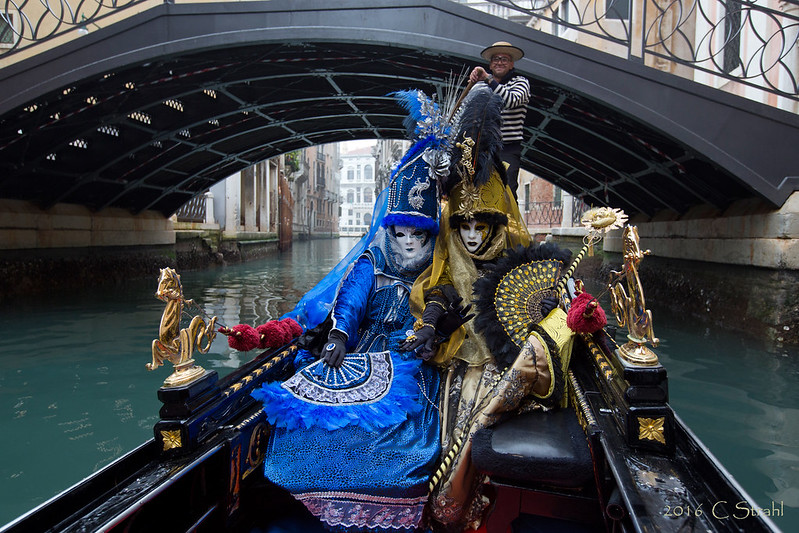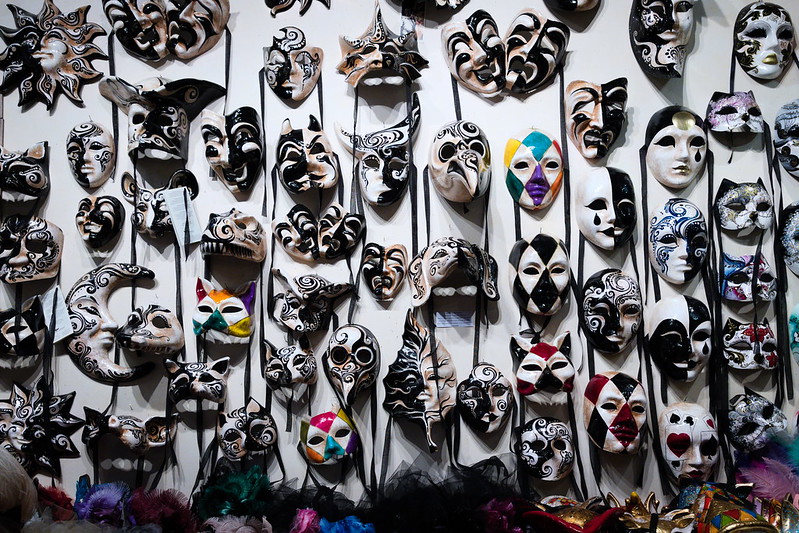Venice Carnival (Carnevale di Venezia)
A Masked Ball of Timeless Elegance
2026/02/06 - 2026/02/23
Every February, the entire city of Venice transforms into a stage for an elaborate masked ball. During the "Carnevale di Venezia", St. Mark's Square and the narrow alleys along the canals are filled with people dressed in luxurious 18th-century costumes and wearing intricate masks. Masks adorned with gold leaf and feathers, glamorous velvet and silk dresses, and nobles wearing tricorn hats and capes create a fantastical scene as if time has stood still. Throughout the city, live Baroque music performances and acrobatic shows unfold, while the aroma of traditional Carnival sweets like frittelle and galani wafts through the air. This festival, which attracts about 3 million tourists, began as one of the few opportunities in medieval Venice's strict class society for people to hide their identities and act freely, and continues to captivate people to this day.
Main Attractions
Grand Opening: Festa Veneziana sull'acqua
On Saturday, January 27th, the first day of Carnival, the Grand Canal bustles with a spectacular water parade at dusk. About 100 gondolas and small boats, decorated with gold leaf and vibrant fabrics, slowly advance illuminated by torchlight. On board, performers in 18th-century costumes showcase dances and acrobatics to Baroque music. The acrobats' performance of diving into the water from a trapeze particularly astounds the audience. About 100,000 spectators gather along the shores, with cheers and applause echoing across the canal.
Il Volo dell'Angelo (The Flight of the Angel)
At noon on Sunday, February 4th, about 50,000 spectators gather in St. Mark's Square. Suddenly, an "angel" in a white feathered costume appears atop the 98.6-meter-high bell tower of St. Mark's Basilica. As the crowd holds its breath, the "angel" glides slowly along an 80-meter wire stretched from the bell tower to the center of St. Mark's Square at a speed of about 1 meter per second. This role is performed by an 18-year-old woman chosen from the previous year's Marie del Carnevale contest, who waves to the gathered crowd while scattering confetti and flower petals during her descent.
Masked Balls
During the Carnival period, masked balls are held in about 20 palazzos (palaces) across Venice every night from 9 PM. The most lavish of these is the "Il Ballo del Doge" held at the Ca' Vendramin Calergi Palace. Despite the high entrance fee of about 500 euros, every year about 400 participants don 18th-century costumes and masks, dancing gracefully to waltzes in grand halls illuminated by chandeliers. Venetian Prosecco and Bellini cocktails are served at the venue, and the ball, which continues until late at night, is enveloped in a fantastical atmosphere as if time has stopped.
The World of Elaborate Costumes and Masks
During the Carnival period, the streets of Venice become like a living art gallery. As you walk through the city, you'll see intricately crafted masks peering out from every corner, from classic white volto masks to long-nosed medico della peste masks. Particularly eye-catching are the luxurious masks decorated with gold leaf and feathers. These not only conceal identities but also lend a mysterious charm to the wearer.
Costumes range from faithful reproductions of 18th-century attire to creative and fantastical designs. The feel of heavy brocade and silk against the skin, and the sight of feathers swaying lightly, create a dreamlike sensation. Carnival participants, adorned in these costumes and masks, parade through the streets, their appearance like a scene straight out of a movie.
Carnival Culinary Delights
Delicious food is an essential part of the Venice Carnival. Frittelle are sweet fried pastries unique to this season, with a fluffy dough filled with cream or raisins. Their crispy exterior and moist interior create a texture that brings happiness with every bite.
Another popular treat is Galani, thin and crispy fried pastries. Generously dusted with powdered sugar, Galani are characterized by their light sweetness and are perfect as an easy-to-eat snack. At local wine bars, you can also enjoy small dishes called Cicchetti. These bite-sized offerings, such as baccalà mantecato (creamed salt cod) and sarde in saor (sweet and sour sardines), symbolize Venice's rich culinary culture.
Cultural and Historical Background: A Thousand-Year Story Hidden Behind the Mask
The Venice Carnival is more than just a festival; it's a cultural event that embodies the very soul of the city. Its origins date back to the 11th century, said to have begun as spontaneous dancing by citizens celebrating a military victory over Aquileia. Officially recognized in 1296, this festival evolved alongside the glory of the Venetian Republic, reaching its peak in the 18th century.
The most important cultural aspect of the Carnival is the concept of "equality" symbolized by the masks. In Venice's strict class society, during the Carnival period, both nobles and commoners became equal under their masks, freed from social constraints. This "mask culture" greatly influenced Venetian art and literature, and by 1436, mask-making was recognized as an official profession.
After a long interruption following Napoleon's invasion, the revival of the Carnival in 1979 signified the rebirth of Venice's cultural identity. Today's Carnival, while inheriting past traditions, has evolved into a venue for new artistic expression and international exchange. The Carnival, which now attracts over 3 million visitors annually, has become a place where Venice's historical charm and modern creativity merge.
For Venetian citizens, the Carnival is not just a tourist event. It's an important opportunity to celebrate their cultural heritage and pass it on to future generations, embodying the spirit of the "City of Water". These two weeks, where past and present, tradition and innovation intersect under the masks, are moments when Venice once again shines as "La Serenissima" (The Most Serene Republic).
Participant Voices
Participating in the Venice Carnival changed my perspective on life. As an exchange student from Japan, I was initially overwhelmed by the language barrier and cultural differences, but everything changed the moment I put on the mask. The locals were surprisingly kind, encouraging me to "Let loose more! Sing joyfully!" During practice, even when I thought I was singing and dancing with all my might, I was told I was "too quiet," so I practiced desperately for the main event. On the day of the parade, I struggled with the heavy and hot costume, but the moment I felt accepted, dancing together with everyone, is unforgettable. The Carnival wasn't just a festival; it was a magical experience that transcended cultural barriers.
As a student of art history, I had always dreamed of experiencing the Venice Carnival. However, the reality far exceeded my imagination. At the Doge's Ball, I found myself waltzing in an 18th-century gown, my face hidden behind an authentic Bauta mask. A gentleman in a tricorn hat and cape leaned in and whispered, "Tonight, we are all nobles of Venice." In that instant, I understood the transformative power of the Carnival – it's not just a celebration, it's a portal to another time.
Fun Facts
- The word "Carnevale" comes from the Latin "carnem levare" or "farewell to meat", referring to the period of fasting during Lent.
- The longest Venice Carnival lasted for six months, from October 1798 to March 1799.
- Venetian masks were once banned outside of the Carnival period and could only be worn for 15 days a year.
- The traditional Venetian mask makers are called "mascherari" and have had their own guild since 1436.
- During the 18th century, the famous Venetian lover Giacomo Casanova used the anonymity of Carnival to conduct many of his amorous adventures.
Festival Dates
The Venice Carnival typically takes place in the two weeks leading up to Lent, with dates varying each year based on the Easter calendar.
The event schedule is subject to change. Please check the official website for the most up-to-date information.
Information
| Name | Venice Carnival (Carnevale di Venezia) |
| Country | Italy |
| Area | Venezia, Piazza San Marco |
| Date | 2026/02/06 - 2026/02/23 |
| Link |
Upcoming Festivals
Whirling Dervishes Festival Turkey
A Mesmerizing Dance of Divine Love
2025/12/06Mevlana Celaleddin Rumi Commemoration Ceremony ( Şeb-i Arus ) Turkey
A Whirling Journey to Divine Love
2025/12/10Dia de la Virgen de Guadalupe Mexico
A Festival Weaving Faith, Fervor, and Mexican Identity
2025/12/11L'Escalade Switzerland
Geneva’s Grand Winter Festival of Courage, Chocolate, and Community
2025/12/12Umkhosi Wokweshwama South Africa
The Zulu First Fruits Festival—A Sacred Celebration of Land, Ancestors, and Renewal
2025/12/12Lucia Festival (St. Lucia's Day) Sweden
A Festival of Light Illuminating the Nordic Darkness
2025/12/15Las Posadas Mexico
The Luminous Quest for Sacred Shelter
2025/12/22Noche de Rabanos (Night of the Radishes) Mexico
A celebration blending art, farming heritage, and cultural traditions
2025/12/23Chant of the Sybil on Majorca Spain
A Medieval Prophecy Echoes Through Majorcan Christmas
2025/12/23‘Hatajo de Negritos’ and the ‘Hatajo de Pallitas’ Peru
A Christmas Festival of Rhythm, Faith, and Afro-Andean Heritage in Peru’s Ica Region



